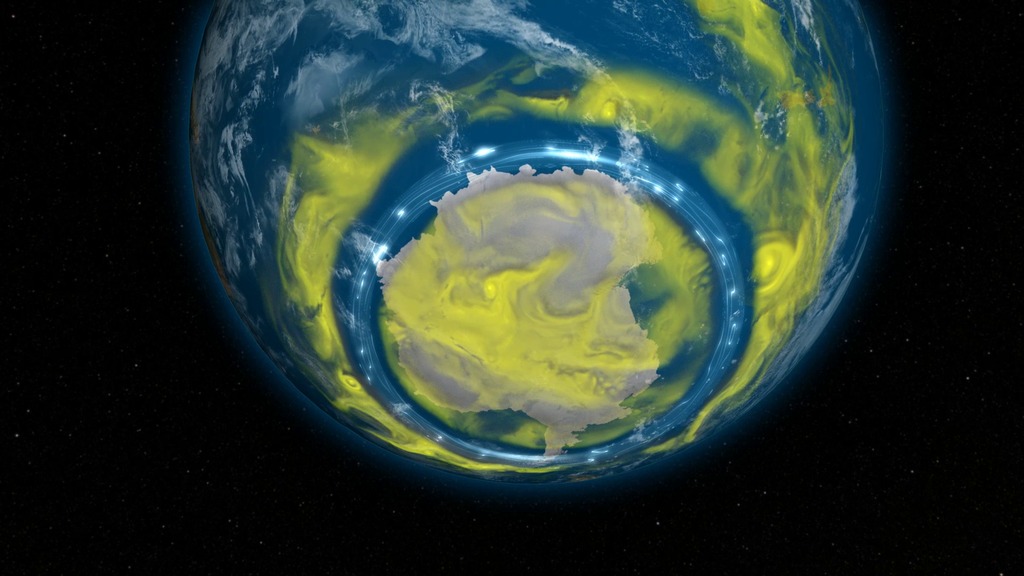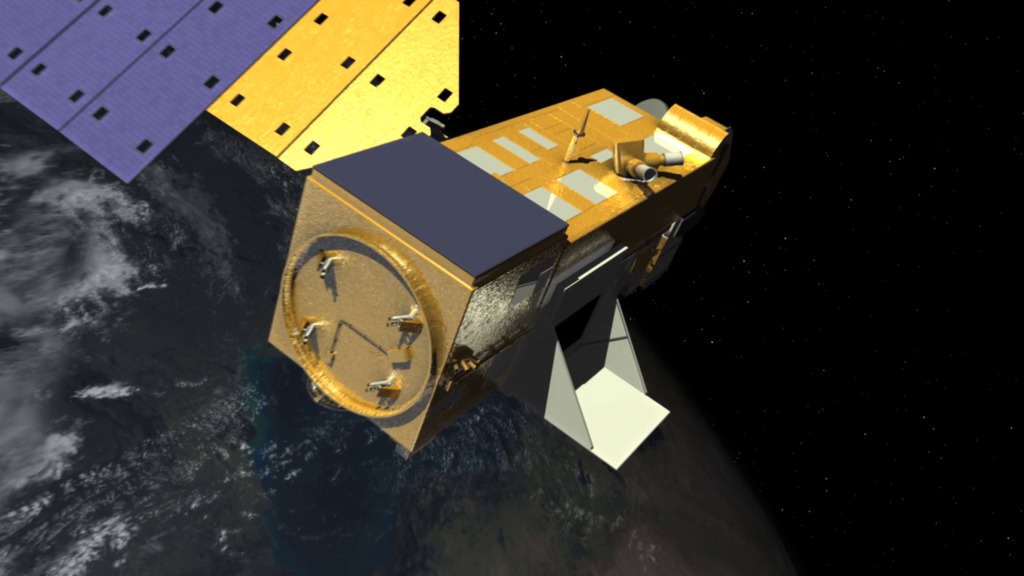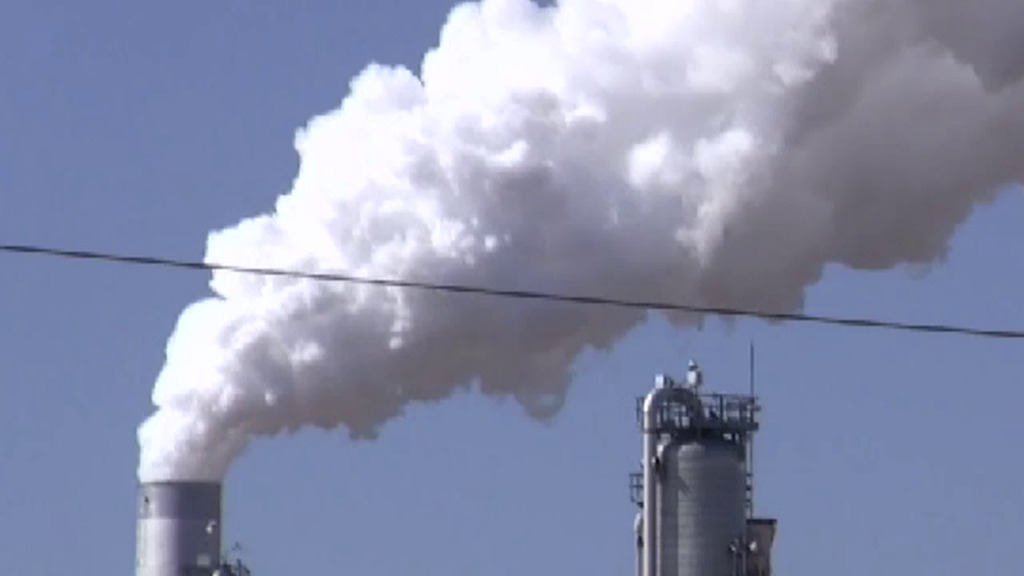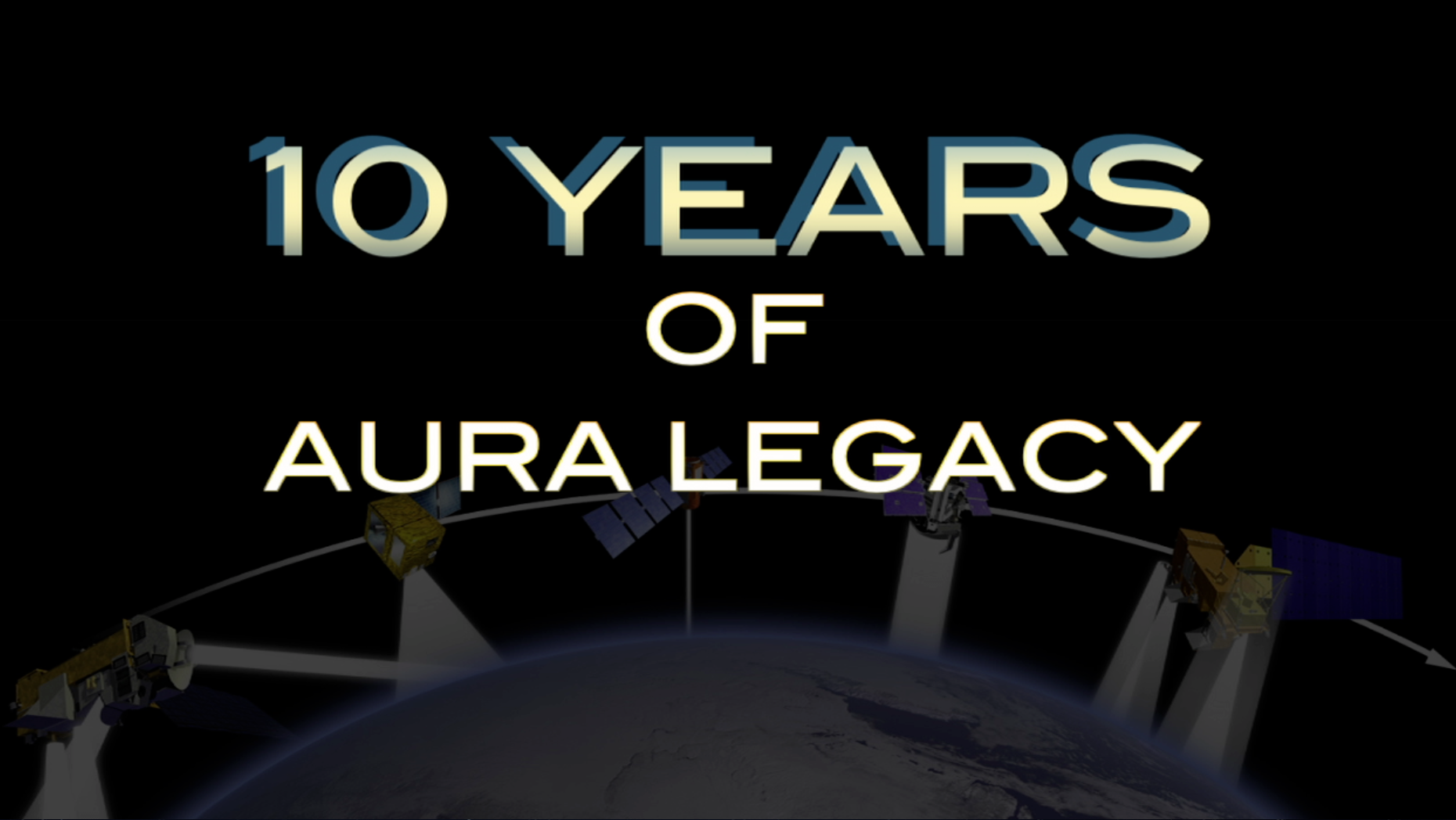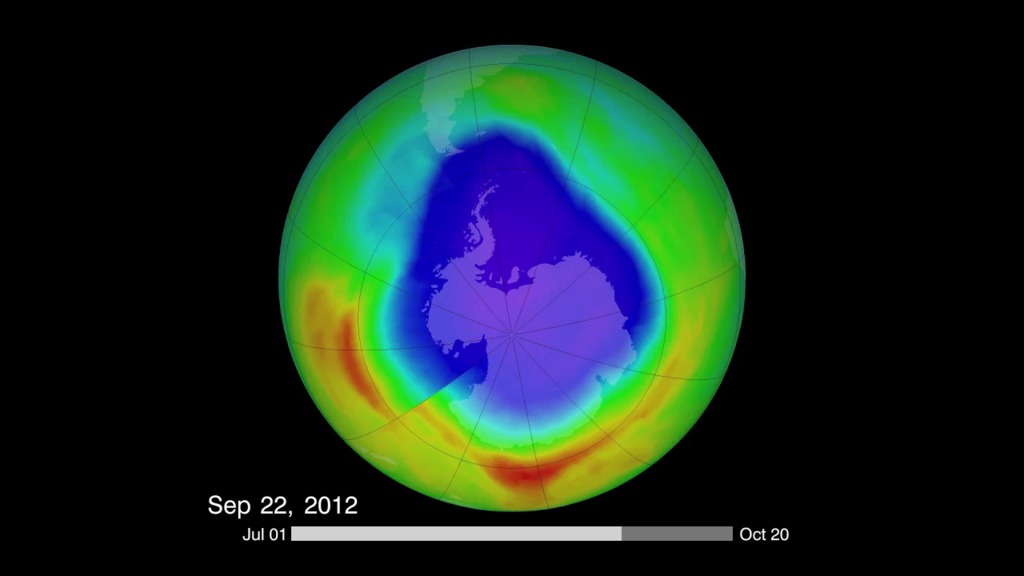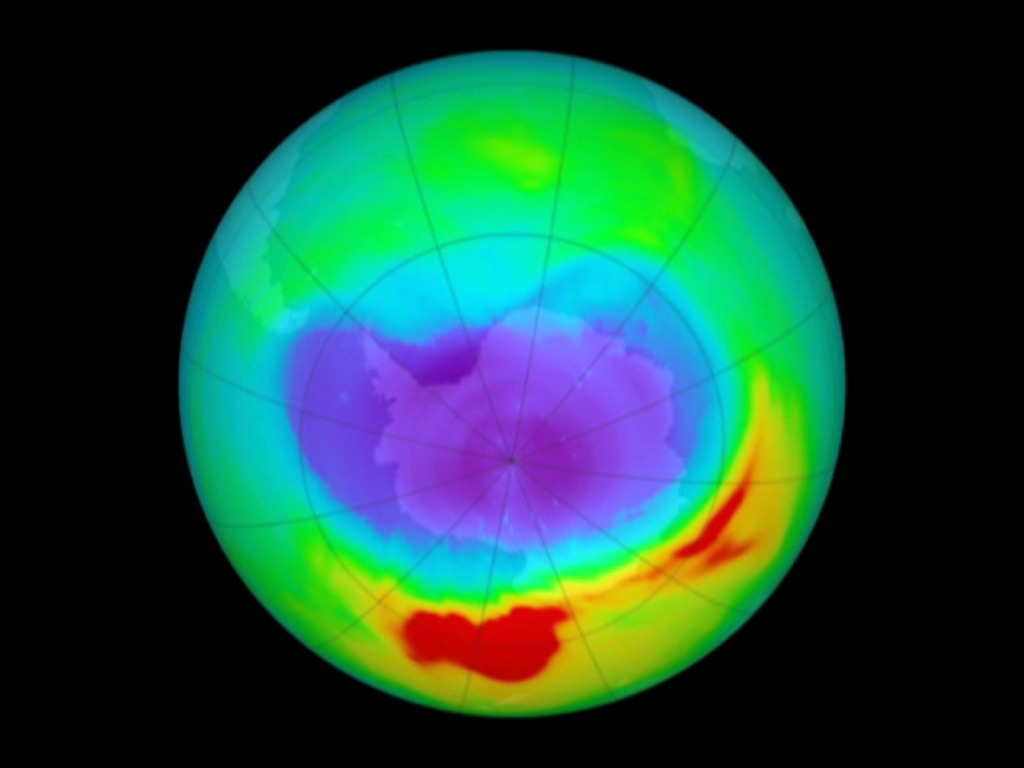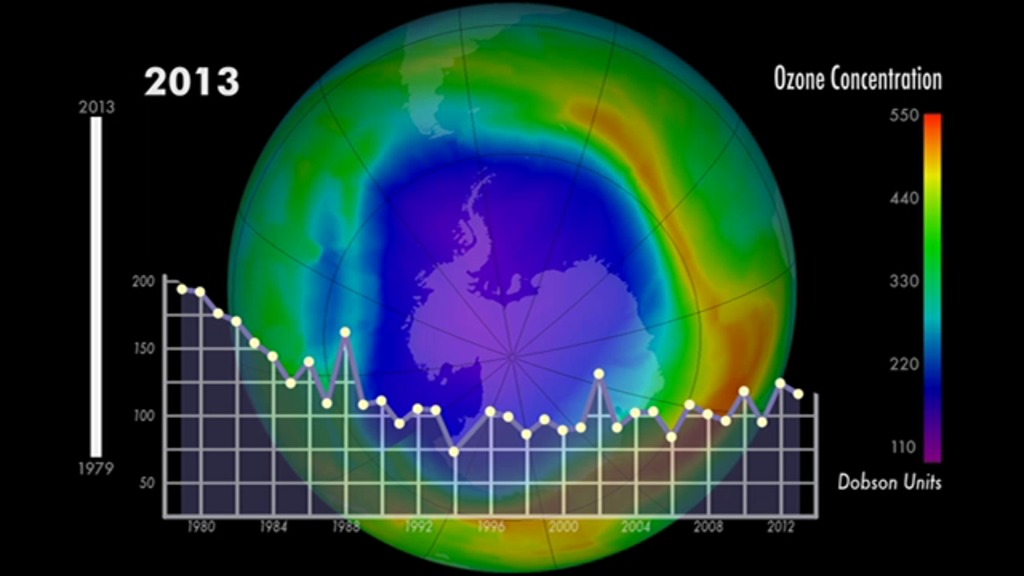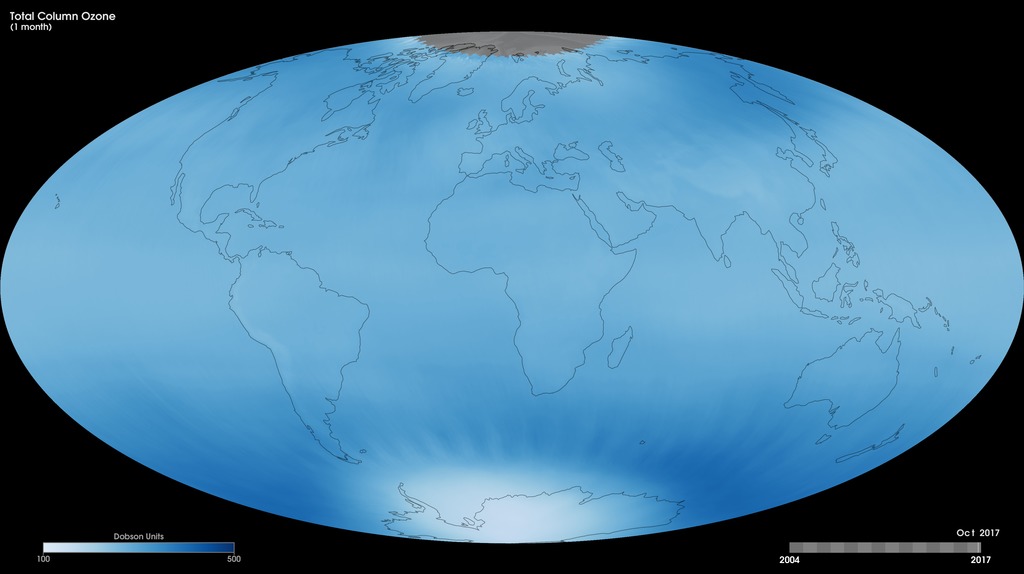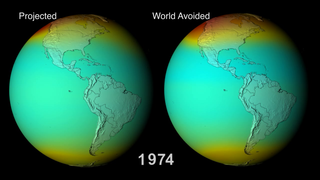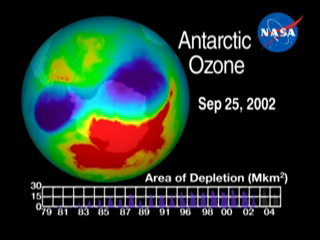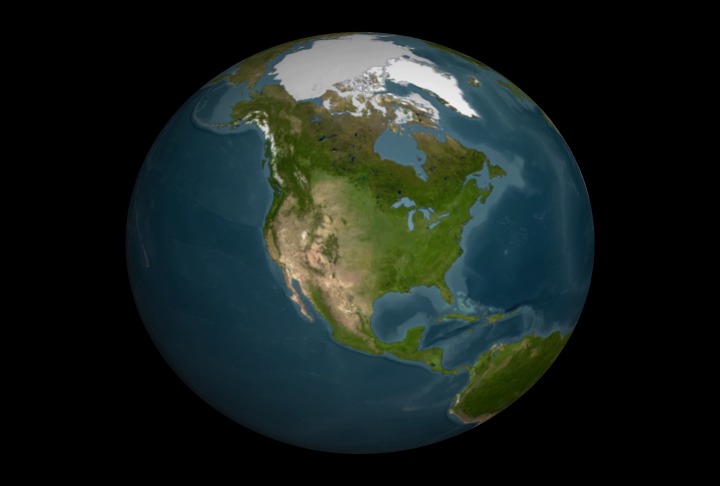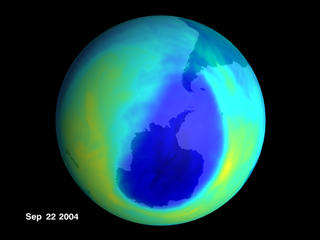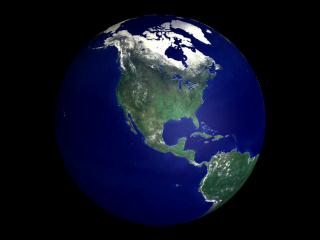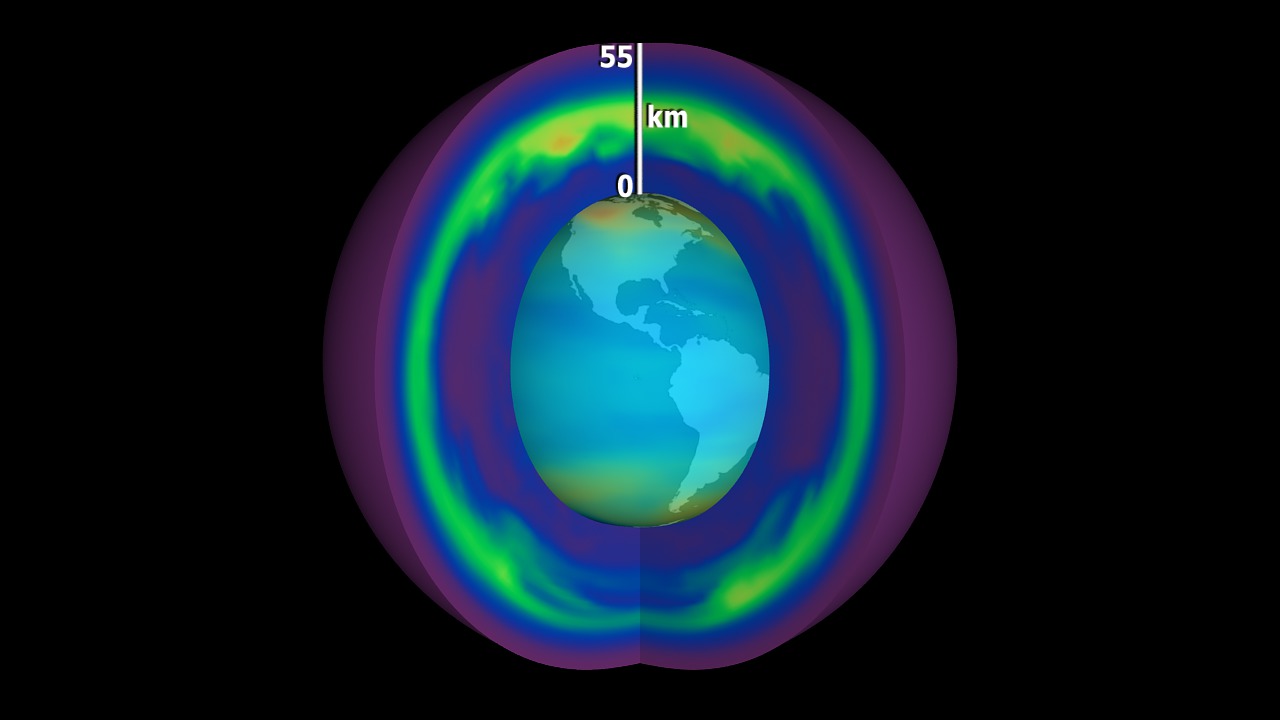Ozone Hole
Overview
Visualizations and narrated videos about stratospheric ozone, for educators and the press.
Narrated Videos
Big Ozone Holes Headed For Extinction By 2040
Go to this pageThe next three decades will see an end of the era of big ozone holes. In a new study, scientists from NASA Goddard Space Flight Center say that the ozone hole will be consistently smaller than 8 million square miles by the year 2040.Ozone-depleting chemicals in the atmosphere cause an ozone hole to form over Antarctica during the winter months in the Southern Hemisphere. Since the Montreal Protocol agreement in 1987, emissions have been regulated and chemical levels have been declining. However, the ozone hole has still remained bigger than 8 million square miles since the early 1990s, with exact sizes varying from year to year.The size of the ozone hole varies due to both temperature and levels of ozone-depleting chemicals in the atmosphere. In order to get a more accurate picture of the future size of the ozone hole, scientists used NASA’s AURA satellite to determine how much the levels of these chemicals in the atmosphere varied each year. With this new knowledge, scientists can confidently say that the ozone hole will be consistently smaller than 8 million square miles by the year 2040. Scientists will continue to use satellites to monitor the recovery of the ozone hole and they hope to see its full recovery before the end of the century.Research: Inorganic chlorine variability in the Antarctic vortex and implications for ozone recovery.Journal: Geophysical Research: Atmospheres, December 18, 2014.Link to paper: http://onlinelibrary.wiley.com/doi/10.1002/2014JD022295/abstract.Here is the YouTube video. ||
Why is the Ozone Hole Getting Smaller?
Go to this pageThe Antarctic ozone hole reached its annual peak size on Sept. 11, according to scientists from NASA and the National Oceanic and Atmospheric Administration (NOAA). The size of this year’s hole was 24.1 million square kilometers (9.3 million square miles) — an area roughly the size of North America.With the increased atmospheric chlorine levels present since the 1980s, the Antarctic ozone hole forms and expands during the Southern Hemisphere spring (August and September). The ozone layer helps shield life on Earth from potentially harmful ultraviolet radiation that can cause skin cancer and damage plants.The Montreal Protocol agreement beginning in 1987 regulated ozone depleting substances, such as chlorine-containing chlorofluorocarbons and bromine-containing halons. The 2014 level of these substances over Antarctica has declined about 9 percent below the record maximum in 2000.“Year-to-year weather variability significantly impacts Antarctica ozone because warmer stratospheric temperatures can reduce ozone depletion,” said Paul A. Newman, chief scientist for atmospheres at NASA's Goddard Space Flight Center in Greenbelt, Maryland.Scientists are working to determine if the ozone hole trend over the last decade is a result of temperature increases or chorine declines. An increase of stratospheric temperature over Antarctica would decrease the ozone hole’s area. ||
Ozone-Depleting Compound Persists
Go to this pageEarth's atmosphere contains an unexpectedly large amount of an ozone-depleting compound from an unknown source decades after the compound was banned worldwide.The compound, carbon tetrachloride, was used in applications such as dry cleaning and as a fire-extinguishing agent, until its regulation in 1987 under the Montreal Protocol along with other chlorofluorocarbons that destroy ozone and contribute to the ozone hole over Antarctica. Parties to the Montreal Protocol reported zero new emissions between 2007-2012.However, new research led by Qing Liang at NASA's Goddard Space Flight Center in Greenbelt, Maryland, shows that worldwide emissions of carbon tetrachloride average 39 kilotons per year – approximately 30 percent of peak emissions prior to the international treaty going into effect. Now that scientists have quantified the emissions they can begin investigating where they are coming from. Are there industrial leakages, large emissions from contaminated sites, or some other unknown source? ||
10 Years of Aura Legacy
Go to this pageThe Aura atmospheric chemistry satellite celebrates its 10th anniversary in July, 2014. Since its launch in 2004, Aura has monitored the Earth's atmosphere and provided data on the ozone layer, air quality, and greenhouse gases associated with climate change. ||
2012 Ozone Hole Max
Go to this pageAn ozone hole forms above Antarctica every year. This year it reached its max on Sept. 22, 2012, but it is smaller than in the past because of usual variations in Antarctic weather conditions. The ozone hole reached its largest size six years ago, in 2006, when it covered more than 11 million square miles. World adherence to the Montreal Protocol-an international treaty that regulated the use of CFCs-has helped protect the ozone layer. Scientists expect the ozone layer to return to 1980 levels by 2050. ||
Exploring Ozone
Go to this pageThis short video combines dynamic ozone visualizations with an interview with leading atmospheric NASA scientist, Dr. Paul Newman. Dr. Newman explains why ozone is important, he cites the ingredients that cause an ozone hole to form, and he remarks on the future of the ozone, pointing to exciting new areas of ozone research, including the role climate change will play in future years. ||
Visualizations
Ozone minimum concentrations, 1979-2013
Go to this pageVisualizations of ozone concentrations over the southern hemisphere.Data is from ozonewatch.gsfc.nasa.gov ||
Monthly Total Column Ozone
Go to this pageOzone gas is a form of oxygen in which each molecule has three oxygen atoms instead of two. Near the ground, ozone is a pollutant that forms when byproducts of burning coal, oil, or gasoline mix with water vapor in the presence of sunlight. In the stratosphere, however, ozone forms naturally and absorbs harmful ultraviolet radiation known as UV-B. The Ozone Monitoring Instrument (OMI) on NASA’s Aura satellite provides daily total-column ozone, which is how much ozone is present in a column of the atmosphere stretching from the surface to the top of the atmosphere. Therefore, it includes both ground-level and stratospheric ozone.These maps show monthly total-column ozone as measured by OMI from October 2004 to the present. Ozone concentrations are measured in Dobson Units. A Dobson Unit is the amount of ozone that would be required to create a layer of pure ozone 0.01 millimeters thick at the Earth’s surface, at a temperature of 0 degrees Celsius and a pressure of 1 atmosphere. ||
2012 Ozone Hole Max
Go to this pageAn ozone hole forms above Antarctica every year. This year it reached its max on Sept. 22, 2012, but it is smaller than in the past because of usual variations in Antarctic weather conditions. The ozone hole reached its largest size six years ago, in 2006, when it covered more than 11 million square miles. World adherence to the Montreal Protocol-an international treaty that regulated the use of CFCs-has helped protect the ozone layer. Scientists expect the ozone layer to return to 1980 levels by 2050. ||
What Would have Happened to the Ozone Layer if Chlorofluorocarbons (CFCs) had not been Regulated?
Go to this pageLed by NASA Goddard scientist Paul Newman, a team of atmospheric chemists simulated 'what might have been' if chlorofluorocarbons (CFCs) and similar ozone-depleting chemicals were not banned through the Montreal Protocol. The comprehensive model — including atmospheric chemical effects, wind changes, and solar radiation changes — simulated what would happen to global concentrations of stratospheric ozone if CFCs were continually added to the atmosphere.The visualizations below present two cases, from several different viewing positions: the 'world avoided' case, where the rate of CFC emission into the atmosphere is assumed to be that of the period before regulation, and the 'projected' case, which assumes the current rate of emission, post-regulation. Both cases extrapolate to the year 2065. ||
The 2005 Antarctic Ozone Hole
Go to this pageA relatively warm Antarctic winter in 2005 kept the thinning of the protective ozone layer over Antarctica, known as the ozone 'hole,' slightly smaller than in 2004. The ozone hole is not technically a 'hole' where no ozone is present, but is actually a region of exceptionally depleted ozone in the stratosphere over the Antarctic that happens at the beginning of Southern Hemisphere spring (August-October). The average concentration of ozone in the atmosphere is about 300 Dobson Units; any area where the concentration drops below 220 Dobson Units is considered part of the ozone hole. Each year the 'hole' expands over Antarctica, sometimes reaching populated areas of South America and exposing them to ultraviolet rays normally absorbed by ozone. This data was acquired by the Ozone Monitoring Instrument on NASA's Aura satellite, NASA's newest tool to study this annual phenonmenon. On September 15, 2005, ozone thinning over Antarctica reached its maximum extent for the year at 24.2 million square kilometers (9.4 million square miles). The largest maximum area on record was 29.2 million square kilometers, in 2000. ||
Smithsonian Exhibit: Antarctic Ozone Sequence 1979 through 2004
Go to this pageNASA has been monitoring the status of the ozone layer through satellite observations since the 1970s, beginning with the TOMS sensors on the Nimbus satellites. The latest-generation ozone-monitoring technology, the Ozone Monitoring Instrument (OMI), is flying onboard NASA's Aura satellite. The ozone hole is not technically a 'hole' where no ozone is present, but is actually a region of exceptionally depleted ozone in the stratosphere over the Antarctic. The ozone hole begins to grow in August and reaches its largest area in depth in the middle of September to early October period. In the early years (before 1984) the hole was small because chlorine and bromine levels over Antarctica were low. Year-to-year variations in area and depth are caused by year-to-year variations in temperature. Colder conditions result in a larger area and lower ozone values in the center of the hole. This animation shows total ozone in the Antarctic region along with the maximum ozone depth and size since the earliest measurements of Earth Probe instrument on the TOMS satellite. This animation was created for an exhibit at the Smithsonium Museum. Data dropouts have been removed for the following times: 1998/12/14-31, 2002/08/03-11, 2003/11/28-2003/12/02. The minimum ozone recorded is 82.0 du on September 26, 2003. The maximum area of 29 million square kilometers (11.4 million square miles) occurred on September 9, 2000. ||
Aura/OMI Ozone Hole from September 12, 2004 to November 15, 2004 with Polar Vortex Demarcation
Go to this pageData from NASA satellites establishes a 40-year record of stratospheric ozone measurements. The stratospheric ozone layer shields life on Earth from harmful solar ultraviolet (UV) radiation. Research shows that excess exposure to UV radiation causes skin cancer and eye problems and impacts plant growth. Global stratospheric ozone has decreased by 3 percent globally between 1980 and 2000 and has thinned by 50 percent over Antarctica in winter and spring. Depletion of the ozone layer allows more UV radiation to reach the Earth's surface.This animation shows the ozone layer blocking harmful UV radiation from the Earth's surface. The hole in the ozone is seen in purple. The location, size, and shape of the polar vortex is derived from potential vorticity data, PV. The PV, shown in white at 550 degrees Kelvin, is an atmospheric regional event that isolates polar air from the air at lower latitudes, producing conditions favorable for wintertime polar ozone depletion. The animation shows that most of the low-temperature and chemically-perturbed region is confined within the polar vortex during the Antarctic winter. ||
The 2004 Antarctic Ozone Hole
Go to this pageA relatively warm Antarctic winter in 2004 kept the thinning of the protective ozone layer over Antarctica, known as the ozone 'hole,' slightly smaller than in 2003. Each year the 'hole' expands over Antarctica, sometimes reaching populated areas of South America and exposing them to ultraviolet rays normally absorbed by ozone. Scientists have new tools to study this annual phenomenon, and the human-produced compounds that contribute to ozone breakdown are decreasing.On September 22, 2004, ozone thinning over Antarctica reached its maximum extent for the year at 24.2 million square kilometers (9.4 million square miles). The largest maximum area on record was 29.2 million square kilometers, in 2000. On October 5, 2004, the ozone layer reached a low value of 99 Dobson Units. ||
Antarctic Ozone from TOMS: August 1, 2003 to November 27, 2003
Go to this pageThe 2003 Antarctic ozone hole was the second largest ever observed, according to scientists from NASA, the National Oceanic and Atmospheric Administration (NOAA), and the Naval Research Laboratory (NRL). The Antarctic ozone 'hole' is defined as thinning of the ozone layer over the continent to levels significantly below pre-1979 levels. Ozone blocks harmful ultraviolet 'B' rays. Loss of stratospheric ozone has been linked to skin cancer in humans and other adverse biological effects on plants and animals. The size of the 2003 Antarctic ozone hole reached 10.9 million square miles on September 11, 2003, slightly larger than the North American continent, but smaller than the largest ever recorded, on September 10, 2000, when it covered 11.5 million square miles. This animation is an update to animation ID 2809 — this version includes about 2 additional months of data. ||
TOMS Ozone Holds Key to Ozone Trends (with Height Indicator)
Go to this pageChemicals and transport process have led to changes in the stratospheric ozone. Scientists need measurements of many different chemical species to puzzle out the observed changes. Aura data will improve our capability to predict ozone changes and help untangle the roles of transport and chemistry in determining ozone trends. This sequence starts with the actual size of our thin fragile part of our atmosphere that carries ozone. Then, the atmosphere is magnified. Inside, is a dynamic and active system of chemicals that moves ozone throughout our atmosphere. ||
